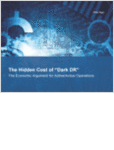 | Traditional Disaster Recovery (DR) methods rely on an active/passive model in which enterprises maintain business continuity by failing over from active systems to secondary, idle systems (typically in a geographically disparate location) configured to be similar or identical to the primary systems. From an operations perspective, the passive systems remain “dark” until needed, leading to the active/passive being commonly called “dark DR.” In contrast, the active/active model constantly shares operations between two active sites. If Site A fails, then its workload flows to Site B. Both sites have sufficient capacity to accommodate the full operational load, although the higher utilization may result in a marginal performance drop during the failover. Both models have their pros and cons. Traditionally, active/active operations were seen as too expensive and technically challenging to implement. New technologies at the data tier mitigate the technical risk, and a deep cost analysis reveals only a 20% premium for active/active operations, which deliver a far superior uptime and performance experience (see following graphic and “Economics” graphic on Page 4.) Given organizations’ intolerance for downtime in this environment of digital transformation, active/active is the clear choice for running operations today. Request Free! |
